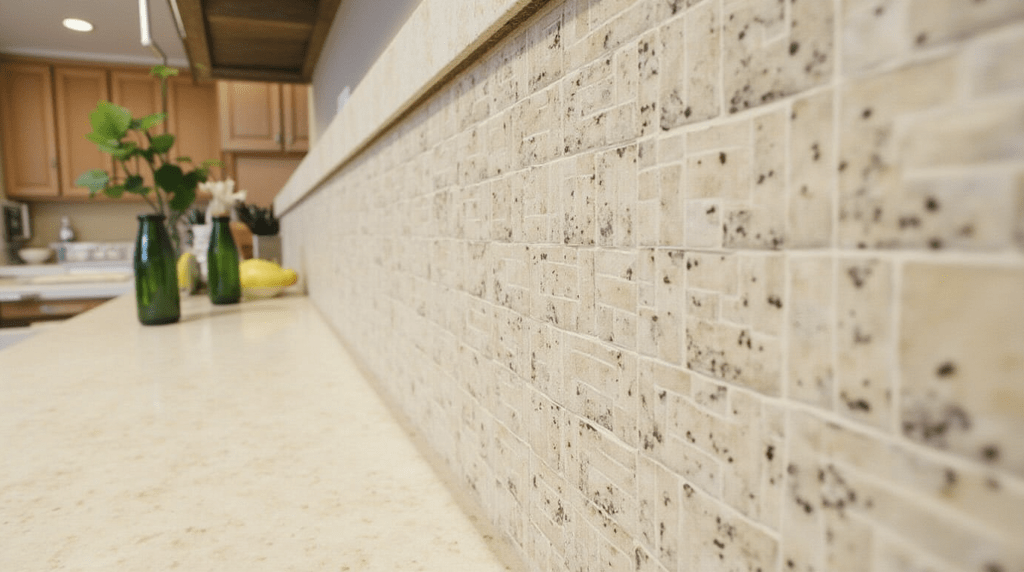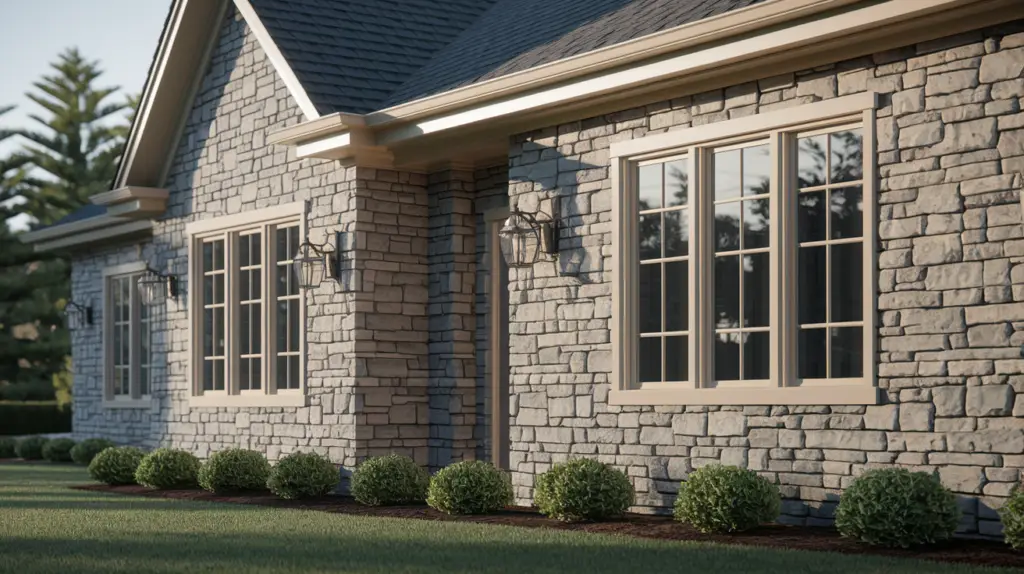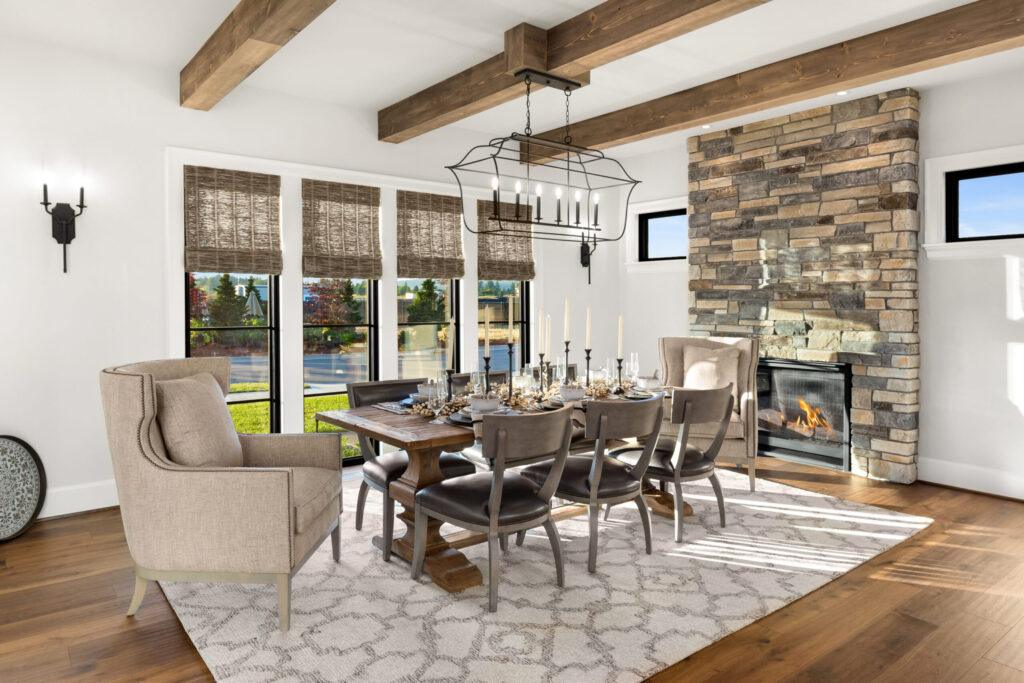For thousands of years, mosaic artisans have transformed small pieces of stone into breathtaking decorative surfaces. Among the most beloved materials for this ancient art form is travertine—a natural stone with distinctive character and warm, earthy tones. Today, travertine mosaic tiles continue this rich tradition, offering homeowners and designers a perfect balance of natural beauty, durability, and design versatility.
In this comprehensive guide, we’ll explore the unique characteristics of travertine mosaics, creative design applications, installation considerations, and maintenance tips to help you incorporate these timeless elements into your home.

The Unique Character of Travertine Mosaic
Travertine is a type of limestone formed by mineral deposits from hot springs and underground rivers. This natural formation process creates several distinctive characteristics that make travertine mosaics uniquely beautiful:
Natural Variation and Texture
Each piece of travertine tells a geological story through its:
- Distinctive pitting and holes formed by carbon dioxide bubbles during formation
- Varied color tones ranging from ivory and beige to walnut, gold, and rust
- Unique veining patterns that ensure no two pieces are identical
- Natural textural variations that add depth and visual interest
When arranged in mosaic patterns, these natural variations create a tapestry of subtle color shifts and textural interest that synthetic materials simply cannot replicate.
Historical Significance
Travertine has been used in significant architecture for millennia. From the Roman Colosseum to Renaissance palaces, this stone has been prized for both its beauty and durability. By incorporating travertine mosaics into your home, you connect with this rich architectural heritage.
According to architectural historian Dr. James Parker of the Marble Institute of America, “Travertine represents one of humanity’s oldest building materials, with a proven track record of beauty that endures for centuries rather than decades.”
Popular Travertine Mosaic Patterns
The versatility of travertine allows for countless mosaic arrangements, from classical to contemporary designs:
Classic Mosaic Patterns
- Herringbone: An interlocking pattern creating visual movement and flow
- Basketweave: Alternating rectangular pieces that mimic woven textiles
- Versailles pattern: A multi-sized modular arrangement with old-world elegance
- Hexagonal: Six-sided tiles creating a honeycomb effect
- Chevron: V-shaped patterns that add dynamic energy to spaces
These time-tested patterns have adorned luxury spaces for centuries and continue to bring classical elegance to contemporary homes. At Flomary, we appreciate how these traditional patterns can complement modern home accessories for a balanced design approach.
Contemporary Mosaic Interpretations
Modern designers are reimagining travertine mosaics in exciting new ways:
- Mixed media mosaics: Combining travertine with glass, metal, or ceramic elements
- Dimensional mosaics: Varying tile heights to create textural, 3D effects
- Oversized mosaic elements: Using larger pieces for a more contemporary scale
- Ombré arrangements: Gradual color transitions from light to dark travertine
- Geometric abstractions: Creating modern patterns with ancient materials
These contemporary approaches honor travertine’s natural beauty while creating fresh, innovative looks for modern spaces.
Specialty Mosaic Formats
Beyond traditional square and rectangular tiles, travertine mosaics are available in several specialty formats:
- Splitface mosaics: Featuring textured, dimensional surfaces
- Penny rounds: Small circular tiles arranged in continuous patterns
- Waterjet-cut mosaics: Precision-cut intricate patterns and motifs
- 3D cubes: Creating optical illusion effects through clever arrangement
- Interlocking borders: Specialized patterns for framing larger installations
These specialty formats allow for truly customized expressions that can transform ordinary spaces into extraordinary ones.
Ideal Applications for Travertine Mosaics
The versatility of travertine mosaics makes them suitable for numerous applications throughout the home:
Kitchen Applications
In the heart of the home, travertine mosaics add warmth and character through:
- Backsplashes that protect walls while adding natural beauty
- Feature walls that create a stunning focal point
- Island facades that elevate central workspaces
- Flooring insets that define dining or preparation areas
The natural variations in travertine complement both wood and painted cabinetry, while its earthy tones work beautifully with a wide range of countertop materials.
Bathroom Applications
Travertine mosaics bring spa-like luxury to bathrooms through:
- Shower floors where smaller tiles provide better slip resistance
- Shower accent walls that create visual interest
- Vanity backsplashes that protect walls from water splashes
- Tub surrounds that frame the bathing area
- Floor borders that define spaces within larger bathrooms
The natural, earthy quality of travertine creates a grounding, organic feel perfect for creating a relaxing bathroom retreat.
Living Space Applications
Beyond wet areas, travertine mosaics add sophistication to living spaces through:
- Fireplace surrounds that create a stunning focal point
- Accent walls that add texture and visual interest
- Flooring medallions that define seating areas
- Entryway designs that create memorable first impressions
- Stair risers that transform functional elements into decorative features
These applications allow the natural beauty of travertine to enhance the most visible areas of your home.
Outdoor Applications
Travertine’s durability makes it excellent for outdoor mosaic applications:
- Patio insets that define outdoor living areas
- Pool surrounds with slip-resistant textured finishes
- Outdoor kitchen backsplashes that withstand the elements
- Garden path accents that add artistic touches to landscaping
- Water feature surrounds that complement other natural elements
When selecting travertine for outdoor applications, choose a variety with appropriate density and finish for your climate conditions.
Design Considerations for Travertine Mosaics
To create the most successful travertine mosaic installations, consider these important design factors:
Color Selection
Travertine naturally occurs in a warm, earthy palette that includes:
- Ivory and beige: Light, neutral tones that brighten spaces
- Gold and honey: Warm mid-tones that create a welcoming atmosphere
- Walnut and noce: Rich brown tones that add depth and sophistication
- Silver and gray: Cooler tones for contemporary spaces
- Multi-color blends: Mixed palettes that incorporate several travertine varieties
Consider how these natural tones will interact with your existing color scheme, keeping in mind that travertine tends to warm a space visually.
Finish Options
Travertine mosaics are available in several finishes, each creating a different aesthetic effect:
- Polished: A glossy, reflective surface that highlights the stone’s color variations
- Honed: A smooth but matte finish that offers a more subtle, contemporary look
- Tumbled: A textured, slightly worn appearance with softened edges for rustic charm
- Brushed: A lightly textured surface that balances between honed and tumbled
- Split-face: A highly textured, dimensional surface for maximum visual impact
The finish you select will significantly impact both the appearance and functionality of your mosaic installation.
Grout Considerations
Grout selection dramatically affects the final appearance of travertine mosaics:
- Matching grout: Creates a seamless, monolithic appearance
- Contrasting grout: Emphasizes the pattern and individual tile shapes
- Neutral grout: Provides subtle definition without dominating the design
- Grout width: Narrower grout lines create a more continuous look, while wider lines emphasize the pattern
Consider both aesthetic preferences and practical maintenance when selecting grout color and width for your travertine mosaic installation.
Installation Considerations
Proper installation is crucial for the longevity and beauty of travertine mosaic tiles:
Substrate Preparation
The foundation for any successful mosaic installation includes:
- Ensuring the substrate is clean, level, and free of cracks
- Installing appropriate backer board in wet areas
- Addressing any structural issues before installation begins
- Applying waterproofing membranes in wet locations
According to the Tile Council of North America, proper substrate preparation is the most critical factor in preventing tile installation failures.
Installation Methods
Travertine mosaics are typically installed using one of these methods:
- Mesh-backed sheets: Pre-arranged mosaics on flexible mesh for easier installation
- Paper-faced mosaics: Patterns assembled with paper on the front, removed after installation
- Individual piece installation: Custom patterns created piece by piece for maximum control
Each method has advantages depending on the complexity of your design and installation location.
Sealing Requirements
As a natural stone, travertine requires proper sealing:
- Apply a high-quality penetrating sealer before grouting
- Seal again after grouting to protect both stone and grout
- Reapply sealer periodically based on wear and manufacturer recommendations
- Consider enhanced sealers for wet areas or food preparation surfaces
Proper sealing protects against staining and moisture absorption while enhancing the natural beauty of the stone.
Maintaining Travertine Mosaic Tiles
With proper care, travertine mosaics will maintain their beauty for decades:
Routine Cleaning
- Clean regularly with pH-neutral stone cleaners
- Avoid acidic cleaners (including vinegar) that can etch the stone
- Wipe spills promptly to prevent staining
- Use soft cloths or microfiber for cleaning to prevent scratching
- Consider steam cleaning for deeper maintenance without chemicals
Addressing Common Issues
Even with proper care, travertine may occasionally require special attention:
- Etching: Caused by acidic substances and requiring professional honing to repair
- Staining: Address with appropriate poultice treatments specific to the stain type
- Grout discoloration: Clean with specialized grout cleaners or consider professional recoloring
- Natural holes: These can be filled during installation or left open for authentic character
For specific maintenance challenges, consult with a natural stone specialist to preserve your travertine’s beauty.
Cost Considerations
Travertine mosaic tiles represent a premium flooring and wall covering option, with costs influenced by several factors:
- Tile quality and origin: Premium Italian travertine typically commands higher prices
- Pattern complexity: Custom and intricate patterns increase both material and labor costs
- Finish type: Polished and specialty finishes often cost more than standard options
- Installation complexity: Detailed patterns and difficult locations increase labor costs
While representing a higher initial investment than ceramic or porcelain alternatives, travertine mosaics offer exceptional longevity and timeless appeal that can increase property value.
Design Inspiration: Travertine Mosaic Styles
Travertine mosaics adapt beautifully to various design aesthetics:
Mediterranean and Tuscan
Embrace the stone’s natural connection to Italian architecture with:
- Warm gold and noce travertine in tumbled finishes
- Traditional patterns like Versailles or basketweave
- Terracotta accents and wrought iron accessories
- Rustic, old-world charm with textural variations
Contemporary Minimalist
Update travertine for modern spaces with:
- Large-format mosaic pieces in geometric arrangements
- Honed or polished finishes for sleek surfaces
- Monochromatic color schemes in silver or beige tones
- Minimal grout lines for a continuous appearance
Transitional Elegance
Bridge traditional and contemporary with:
- Classic patterns executed in clean, precise installations
- Mixed finishes that combine polished and honed surfaces
- Subtle color variations that add interest without overwhelming
- Thoughtful borders that frame spaces without dominating them
For complementary home accessories that enhance these design styles, explore the curated collections at Flomary, where we offer pieces that pair beautifully with natural stone elements.
Conclusion
Travertine mosaic tiles represent a perfect marriage of natural beauty, historical significance, and design versatility. Whether used as a subtle accent or dramatic focal point, these timeless elements bring warmth, texture, and sophistication to any space.
The unique character of travertine—with its natural variations, warm tones, and rich texture—creates surfaces that tell a story and connect us to thousands of years of architectural tradition. While requiring some special care, the exceptional durability and enduring appeal of travertine mosaics make them a worthwhile investment for discerning homeowners.
From classical Mediterranean inspirations to contemporary minimalist interpretations, travertine mosaics continue to evolve while maintaining their fundamental connection to the natural world. By incorporating these elements into your home, you create spaces that feel both grounded in tradition and freshly relevant to contemporary living.
Have you incorporated travertine mosaics in your home? We’d love to hear about your experiences and see your creative applications in the comments below!



